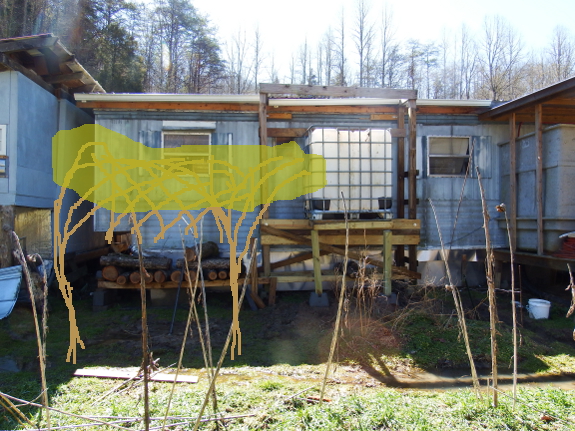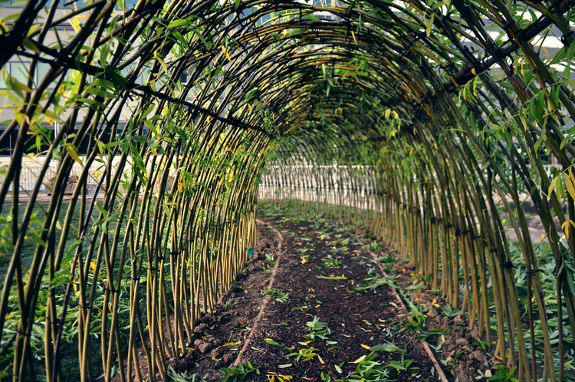
Building with living trees
 I've been pondering a shade house
somewhere on the north side of the trailer for years. The idea is to
have a cool spot for summer dining, mushroom growing, and seed starting
during the hot season while still allowing rain to fall through the
"roof."
I've been pondering a shade house
somewhere on the north side of the trailer for years. The idea is to
have a cool spot for summer dining, mushroom growing, and seed starting
during the hot season while still allowing rain to fall through the
"roof."
But the idea has never quite gelled into a finished form because I'm not quite sure what I want to make the structure out of. So when I stumbled across the photo to the left from Pooktre Tree Shapers, a light bulb went off in my mind. Maybe I need to build my shade house out of...trees!
Building with living
trees has a long history which may have begun with living root bridges
in India. However, those of us lacking a tropical climate can't get away
with using aerial roots for construction. Instead, we have to focus on
temperate-zone trees that grow quickly and (hopefully) have the ability
to easily graft together (inosculate) when nearby branches touch. Plants
that commonly inosculate and might be used for tree sculptures include
apple, almond, ash, beech, crepe myrtle, chestnut, dogwood, elm, fig,
grape, hazelnut, hornbeam, linden (aka basswood), maple, olive, peach,
pear, privet, river red gum, sycamore, willow, and wisteria.
Of these, willow is probably the easiest to use since you can root a
willow cutting simply by sticking the twig in the ground. Plus, the
resulting growth from the willow is malleable and extremely vigorous,
making it easy to shape and quick to grow. Finally, in our wet soil,
willows are bound to thrive, although I should mention those of you
gardening in drier climes might focus instead on elm or plum. (As a side
note, using fruit trees to make structures is enticing, but the
maturation process will be slower and you'll struggle to mesh your
sculptural needs with the plant's fruiting needs. In other words, this
is one instance where I'd probably recommend against going for an
edible-landscape selection.)
What have people built
from living willow trees? Chairs like the one shown at the top of this
post (although that tree is likely a plum), stairs, shade arbors,
arches, pergolas, and the newly named "fedge" (a fence that's also a
hedge because it's alive). I highly recommend this site (which is where I found the photo above) if you're looking for large-scale ideas, or check out this site for an inspiring array of willow fedges.
Now, before you get too
excited, I should tell you that creating structures out of living trees
is a long-term project that can take as much as a decade to fully
mature, so you'll want to think through your plan up front and make sure
you're willing to wait for the finished product. In addition, during
the early years, you're committing to a summer pruning and training campaign much like the one you'd use on a high-density apple orchard.
In general, you'll want to train the young growth into its final shape
as it appears, then rub off new branches that pop up in the wrong spot
during the summer months. After the sculpture matures, you'll still need
to prune perhaps twice a year (which can provide a handy source of goat
fodder or mulch for your garden).

I'm pondering starting
out with a simple arch over our current mushroom station. A lattice of
willows at the back could arch across and merge with two larger trees in
the front to make a shady bower. Now I just need to determine whether
our wild black willows (Salix nigra)
are a good choice for tree sculptures, or whether I should splurge and
buy one of the willow hybrids that are reputed to grow up to 15 feet the
first year. Decisions, decisions....
Want more in-depth information? Browse through our books.
Or explore more posts by date or by subject.
About us: Anna Hess and Mark Hamilton spent over a decade living self-sufficiently in the mountains of Virginia before moving north to start over from scratch in the foothills of Ohio. They've experimented with permaculture, no-till gardening, trailersteading, home-based microbusinesses and much more, writing about their adventures in both blogs and books.
Want to be notified when new comments are posted on this page? Click on the RSS button after you add a comment to subscribe to the comment feed, or simply check the box beside "email replies to me" while writing your comment.


Mom --- I'm glad it tickled your fancy! I agree that the photos are very inspiring!
Charity --- I think the issue with mulberry would be that they don't self-graft easily. You could still create a structure out of them, but would probably want to weave the trees together to consolidate them since the branches won't naturally fuse where they touch.
Rhonda --- I agree, that does seem to be the compromise --- fast growth versus too much growth! And I wish I could find more information on the internet about what these tree sculptures look like in a decade or two. It's hard to plan for the tree's eventual growth while also making it functional in the short term. Definitely will take some experimentation!
Why not build the roof out of a shutter-like structure?
I've seen a moving shutter-roof over a terrace at a house in Swtizerland, and it looked like an off-the-shelf construction. That shutter could be completely closed to be watertight, but could also be opened so that about 4/5 of the surface was open.
Of course you don't have to be that fancy. Making a fixed shutter roof can be done in multiple ways depending on your woodworking skills and how neat you want things to look.